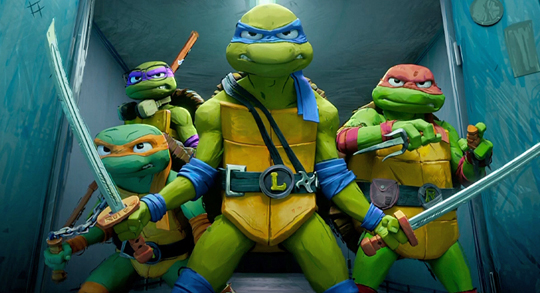
By Mikaela STONE
Although Barbenheimer is a tough act to follow, for the right audience “Teenage Mutant Ninja Turtles: Mutant Mayhem” is the perfect opportunity to say “Cowabunga!” and a chance to dive into local movie theaters for a fun-filled time. The movie presents fresh new takes on well-loved characters. Most notably, it continues the trend that “Spider-Man: Into the Spider-verse” began with a more impressionistic art style that makes the characters feel as though they have walked right out of a comic book.
While the crass humor in which director Seth Rogan specializes (Rogan is a self-identified permanent teenager) may be a stopping block for some, the movie’s wholesome morals, beautiful art style and genuinely loving bonds between its characters more than makes up for it.
In spite of the star-studded cast, including Jackie Chan as Splinter, Ice Cube as Superfly, and John Cena as Rocksteady, one choice made the voice acting stand out so far from every other piece of media in the Teenage Mutant Ninja Turtle movie: It is the first to cast actual teenagers as the turtles.
When Micah Abbey, 15, Brandey Noon, 17, Shamon Brown Jr., 19, and Nicholas Cantu, 19, use Gen Z slang and act their age, it comes off as youthful and genuine in a way that adults mimicking children can often miss – which many TMNT fans were concerned about after the most recent theatrical release for the turtles. That foray – Michael Bay’s “Out of the Shadows” – tried to pass off a gaggle of men aged 29 and older as 17 to the incredulity of longtime TMNT fans.
In “Mutant Mayhem,” when the turtles joke around and act silly they play off one another and talk over each other in the same way that real 15-year old boys do, made possible by the additional decision to record the boys’ lines in the same room and in certain scenes give them free rein to speak however they felt comfortable. The result? A goofy movie that allows young boys to see themselves represented in ways that they actually are rather than an adult’s caricature of a child.
The turtles cover a wide range of personality types with interests ranging from “Attack on Titan” to skateboarding, allowing everyone to see themselves in a turtle.
Parents may see themselves in the turtles’ adopted father Splinter, who is just trying to keep his sons safe. The biggest change from classic TMNT lore is that Splinter is originally a rat rather than a human before his mutation into a rat man. As a rat, he saw the ugliest side of humanity when faced with those deemed “other.”
The movie acknowledges and uplifts both Splinter’s fears and the turtles’ desires for freedom and acceptance in a way that both parents and children can feel good.
The film does not shy away from difficult questions children may be asking themselves at the age of 15, and adults for all of their lives, such as “How far is too far to go for acceptance?” and “What do I owe the people around me?”
It asserts that maybe most people are in fact good people after all, but most people are hurt or scared.
Above all, it shows the many forms a family can take and the importance of the family chosen. After all, sometimes a family can be a rat man and four turtles he found covered in ooze, a camera-shy wannabe reporter and as many weirdos as one can fit in a sewer.
